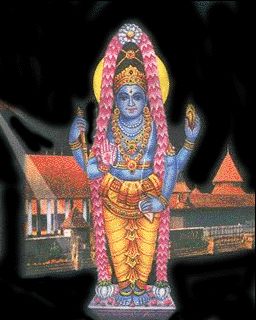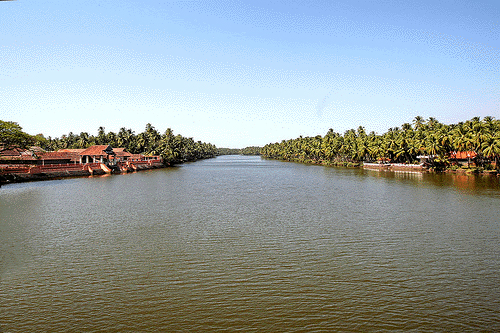
|
|
|
|
The town of Triprayar is in Thissur district, but is well southwest of the city of Thissur itself. The temple site is very recognizable, having a long stretch of walkway along the riverfront, with tank steps and a white and brick-colored fence along the length of the property. The presiding deity at Triprayar is generally understood to be Lord Rama, but it is widely accepted that the deity is also a representation, or amalgamation with Lord Brahma. Others consider it to be Trimurti, ascribing additional elements of Lord Shiva to the deity. Along with the prathistha deity Sri Rama/Brahma are the upaprathisthas, including Sri Gosala Krishna, Ganapati, and Dakshinamurthy.
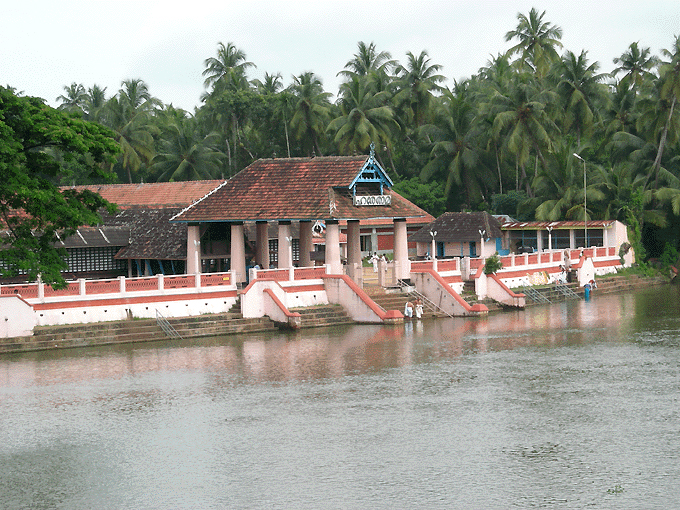
Sree Rama Temple, Triprayar
The deity of Sri Rama is said to have been originally worshiped by Vishnu, then by Lord Brahma, then by Dasaratha the King of Ayodhya, and finally by Sri Krishna at Dwaraka. When Dwaraka sank beneath the sea, the deity of Sri Rama was submerged, along with murtis of Lakshman, Bharata and Shatrughna. Hundreds of years later the deities were discovered by fishermen, who pulled them up in their nets. The fishermen handed Them over to the local chieftain, Vikkal Kaimal, who consulted astrologers to discover the history of the deities. That led to the identification of the site in Triprayar. There was a divine asari who advised Kaimal that the deity of Sri Rama should be installed at the place where a peacock would be visible. All preparations were made for the installation of the deity but days later, no peacock was visible. Finally a devotee carrying a bunch of peacock feathers appeared, and deity was installed in that place. Soon after the installation, a real peacock appeared in front of the sanctum. The temple priests and Kaimal then regretted their earlier decision, and to make up for the deficiency, they installed a sacrificial stone, valiya balikkallu, on the spot actually marked by the peacock. This balikkallu is believed by many to have the same importance as the deity itself. Because the stone had a tendency to spin on its axis, a servitor named Naranathu Bhranthan offered prayers, and drove a nail in at the base to prevent it from moving. Meanwhile, Sri Bharata was installed nearby at Irinjalakuda Koodalnickam, Lakshmana’s murti was installed at Moorikunni village, and Shatrughna was installed at nearby Payamel. Vikkal Kaimal constructed the original shrines at all these places for the respective deities. Sri Rama is worshiped at Triprayar as Maha Vishnu, due to the posture and attributes of the deity. He holds in two hands the bow (kodanda) and garland, and in the other two the chakra and conch. His chest is adorned with srivatsa and kaustubham. Some time later, the saparivara pratishta, or consort deities of Sri Devi and Bhu Devi were placed on either side of Him. The local devotees believe that this deity also represents Lord Brahma, due to the portrayal of Rama with a garland held in his hands. The association with Lord Brahma may also be connected to the pastime of Vamana, and the river. The Rama deity is also said to be in the form of victor over the demon Khara, after which He took on the Shiva aspects, according to which many consider the deity to be Trimurti. Five offerings are made to the deity each day: usha, etirthu, panthirati, uccha, and athazha. The deity is also taken on processional around the temple three times a day. The original deity here, although subject to wear with the passage of time, remains untouched. Astrological investigations revealed that the Lord did not desire to have a change of vigraha, therefore a raiment was crafted in panchaloha (five metals), which now covers the original stone murti.
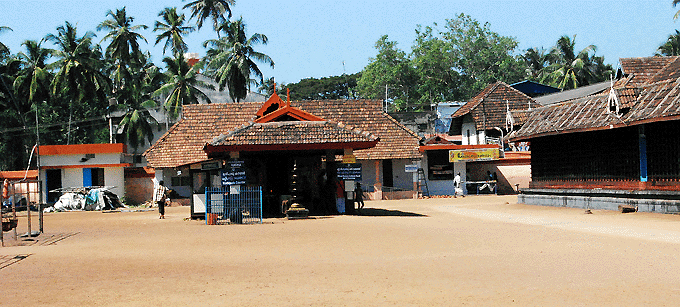
Triprayar Temple Complex In the sanctum sanctorum there are also secondary deities of Dakshinamurthy, facing south, and Ganapathi. Some also ascribe the qualities of Lord Brahma to Sri Dakshinamurthy here. Hanuman is said to be always present at the namaskara mandapa, although there is not a separate murti of him. Devotees make offerings of flattened rice (avil) made from dried paddy for Hanuman. In the outer courtyard is a shrine to Saasta (Ayyappan), which is thought to have originally been located in the sanctum, before the arrival of Lord Rama. North of the main temple is the small shrine of Gosala Krishna. There is no dhwajastambha at this temple. Devotees first offer their prayers to the namaskara mandapa, before worshipping the main deity. The namaskara mandapa faces a circular sanctum (srikovil) having a copper covered conical roof with a golden thazhikakkudam above. The sanctum is ornamented with 24 wood carved panels depicting the navagrahas, and various ancient murals. There are also sculptural scenes from the Ramayana. After Rajasthan, Kerala is home to the second largest collection of devotional murals in India. The mural tradition at Thrissur is an excellent example, the paintings being characterized by great accuracy, adherence to color legends, elaborately embellished, and filled with devotional sentiment. The history of Triprayar Sree Rama Temple is long, and turbulent. It was originally under the Zamorin rule, later taken possession of by the Dutch, the Mysore sultans, then the rulers of Cochin. Triprayar Temple is located on land known as Chettuva Island, that was annexed by the Dutch in 1718. When Tipu Sultan came to defeat the Dutch, he also threatened Triprayar temple. Testing the divinity of the Rama deity, he struck at one of the hands, and blood oozed from it. The Sultan immediately took up devotional service to the Lord. To make amends for his attack, he donated land to the temple, which later became part of Cochi, and was given over to the Nampoothiri families. It was eventually placed under the control of the Cochin Devaswom Board.
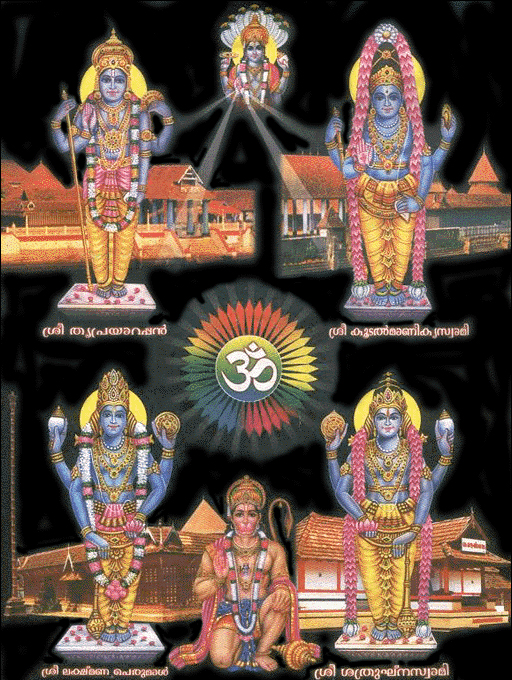
Nalambalam Darshan
The Nalambalam Pilgrimage is an annual pilgrimage devotees make to take darshan of Lord Rama and his associates, at temples in close proximity to one another. The Nalambalam circuit begins at the Sree Rama Temple at Triprayar, then proceeds to the Koodalmanickam Bharatha temple at Irinjalakuda, the Lakshmana temple at Moozhikkulam, and the Payammel Sathrughna temple near Irinjalakuda. This is an important event for local devotees, taking place during the Malayalam month of Karkidakam (July-August), when Lord Rama is worshipped and the Ramayana is read in every home. Nalambalam Dharshan must be performed in a single day, between daybreak and noon. Devotees offer prayers at all four temples, getting darshan of the deities, and purification from worldly sins. The tradition of Nalambalam is growing in popularity, and there are three additional sets of Nalambalams in Kerala: one in Kottayam district, one in Ernakulam-Kottayam districts, and another in Malappuram district.
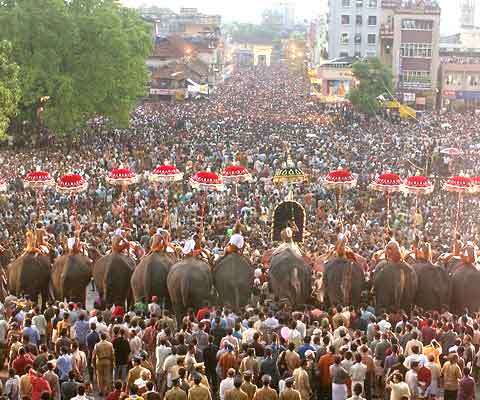
Nalambalam Darshan
There are a number of important festivals and temple events at Triprayar Temple, including the 7-day Pooram festival, celebrated in the Malayalam month of Meenam (March-April). On each of the seven days, a magnificent procession starts out from Triprayar temple, headed for a holy bathing place where arattu (bathing ceremony) is held. Devotees throng to Triprayar to get darshan of the deity on this occasion. During the grand Arattupuzha Pooram, 21 elephants dressed in their royal paraphernalia lead the procession. Only the deity of Shree Rama Temple and kolam are permitted to be carried by elephant. Over the five days in the middle of the festival, the deity is carried out by elephant to visit his devotees in neighboring villages. Here is a wonderful collection of photographs of this Pooram festival, along with a video of the event:
The next most popular gathering at Triprayar is the Ekadashi festival, in the month of Vrischikam (November-December), when a procession of Saasta takes place. Another interesting ritual here is the devotees' feeding of the fish in the river, in honor of Matsya avatar. Fish crowd the banks to eat the grains of rice thrown by the devotees, who consider it a great blessing to be splashed by water from the fish.
Having concluded our tour of Kerala Brahma temples at Triprayar Sree Rama, we would like to close this section with a brief mention of the Brahmarakshas and Parabrahma temples. As mentioned above, there is considerable confusion in postings found online, which attribute temples related to both Brahmarakshas and to Parabrahma as being places of worship of Lord Brahma. Neither is the case.
In Njarakkal there is an 800 year old Bhagavathi temple where the upaprathistas include Siva, Nagaraja, and Sree Brahmarakshas. There is an important differentiation to be made between this Brahmarakshas and the Brahma Rakshas mentioned in previous segments on those found in Jain temples. As previously stated, the Jains have a specific sastric attribution for Lord Brahma's association as a "rakshas", which in their construct is more akin to a household deity, or village deity, compared to the typical Hindu designation of the Rakshasas, which are commonly known as troublemaking personalities generally found in Lord Shiva's retinue.
In Bhagavad-gita 17.4, Sri Krsna states:
yajante sattvika devan "Men in the mode of goodness worship the demigods; those in the mode of passion worship the demons; and those in the mode of ignorance worship ghosts and spirits.
SRILA PRABHUPADA'S PURPORT:
Now, it is clearly described here that those who are in the mode of passion worship and create such gods, and those who are in the mode of ignorance, in darkness, worship dead spirits. Sometimes people worship at the tomb of some dead man. Sexual service is also considered to be in the mode of darkness. Similarly, in remote villages in India there are worshipers of ghosts. We have seen that in India the lower-class people sometimes go to the forest, and if they have knowledge that a ghost lives in a tree, they worship that tree and offer sacrifices. These different kinds of worship are not actually God worship. God worship is for persons who are transcendentally situated in pure goodness."
So although the Njarakkal Bhagavathi temple is often mentioned on lists of India's Brahma temples, the Brahmarakshas there actually represents the spirit of a Brahmin who died an unnatural death. The anguished spirit, who continues to inhabit its familiar surroundings in the material world, is called Brahmarakshas. A similar circumstance was covered in our earlier segment on Sree Ramaswamy Temple in Ramapuram. Finally, we would like to mention the numerous temples in Kerala, and elsewhere in India, that are known as Parabrahma temples. These are sometimes confused as being temples of Lord Brahma, and are more commonly described as representing a convergence or integration of the Trimurti. In fact, "param" means supreme, as Arjuna states in Bhagavad-gita: param brahma param dhama pavitram paramam bhavan. Sri Krsna Himself is Parabrahma, the Supreme Brahma. Most Parabrahma temples, like the one in Oachira, Kerala, do not have deities. Some, like Kerala's Chakkuvally Parabrahma Temple, have murtis on the temple grounds which represent the Lord's shakti. Either way, in no case are the Parabrahma temples actually related to the worship of Lord Brahma. Tomorrow we move on to Tamil Nadu, but for now, we close in a mood of Brahma-bhakti, offering the following prayer to Lord Rama, composed by Lord Brahma himself, as translated by P.R. Ramachander. In the last few verses, Rama is described as Krishna.
Vande devam vishnumasesha sthithi hethum, Thwam adhyathma jnanibhir anthar hrudhi bhavyam, Heya heya dwandwa viheenam paramekam, Sathamathram sarva hrudhistham drusi roopam. 1 I salute that God Vishnu, who remains after destruction everything, Who is the cause, who is meditated upon by realized sages, Who does not have the differences of giving and receiving, Who is only one, who is there but cannot be described, And who is in all hearts and is what one sees. Pranapanou nischaya budhya hrudhi rudhwa, Chithwaa sarvam samsaya bandham vishayoughan, Pasyantheesam yam gatha moha yathayastham, Vade ramam rathna kireetam ravi bhasam. 2 Salutations to the Rama who shines like Sun in his jeweled crown, Who is seen by sages who have completely forsaken mental wishes, Who with a determined mind, contros inhalation and exhalation, And who kills all doubts and controls their minds. Mayatheetham madhavamadhyam jagadhadheem, Manatheetham moha vinasam muni vandhyam, Yogi dhyeyam yoga vidhanmam pari poornam, Vande ramam ranchitha lokam ramaneeyam. 3 Salutations to Rama who attracts the world and steals the mind, Who is beyond illusion, the Lord of Lakshmi and birth place of universe, Who is beyond measurement, killer of passion and is saluted by sages, And who by his mastery of yoga is meditated by yogis and is fully complete. Bhava bhva prathyaya heenam bhava mukhyai, Bhoga sakthair architha padambhuja yugmam, Nithyam shudham budha manantham pranavakhyam, Vande Ramam veeramaseshasura dhavam. 4 Salutations to Rama who destroyed asuras due to his valour, Who is beyond the important concepts of is and is not, Who has a pair of lotus like feet, which is worshipped by those with desire, And who is forever, clean, wise, limitless and is described by Om. Thwam may nadho madhitha karyakhila kari, Manatheetho madhava roopokhila dhari, Bhakthya gamyo bhavitha roopo bhava hari, Yogabhyasair bhavitha chetha sahakari. 5 You are my lord Oh God, who fulfills all wishes made with devotion, Who is beyond measurement and is the Lord Vishnu and various forms taken by him, Who can be attained through devotion, assumes various forms and is the remover of sorrow of life, And who lives in the mind concentrated by yogic practices. Thwam aadhyantham lokathatheenaam parameesam, Lokaanam no loukika mayair adhi gamyam, Bhakthi sradha bhava samthair bhajaneeyam, Vande Ramam Sundara mindee vara neelam. 6 Salutations to Rama who is pretty and of the blue colour of Indivaraksha flowers, Who is the beginning and end, beyond the world and divine God, Who can be known by us measured by ordinary family life, And who can be sung about with devotion, attention and love. Ko vaa jnathum thwamathimanam gathamanam, Manasaktho madhava shaktho muni manyam, Vrundaranye vandaka vrundaravindam, Vande Ramam bhava mukha vandhyam sukha kandam. 7 None are capable of knowing about your intelligence or movement, As you are above measurement and the Lord Vishnu, But you are considered as some one worth knowing by sages, And You are the one saluted by devas in the Vrindavan, And worshipped by Siva and other devas, And my salutations are due to you, Oh Lord Rama. Nana shastrair Veda kadambai prathi padhyam, Nithyanandam nirvishaya jnana manaadhim, Sath sevartham manusha bhavam prathi pannam, Vande Ramam marakatha varnam Madhuresam. 8 Salutations to Rama, who is the king of Mathura and of emerald colour, Who is being dealt by various Shastras and collection of Vedas, Who is forever happy, perennial and having knowledge other than things, And who took the form of man for serving the good people. Sradha yuktho ya padatheem sthavamaadhyam, Brahaamam, brahma jnana vidhanam bhuvi marthya, Ramam shyamam, kamidha kama pradha meesam, Dhyathwa dhyathaa pathaka jaalai vigatha syath. 9 He who reads with attention and devotion, these poems, Composed by Lord Brahma explaining, About knowledge of Brahmam to the men, Meditating on the black coloured Rama, Would be able to fulfill all his desires, And all the sins committed by him are erased.
| |
